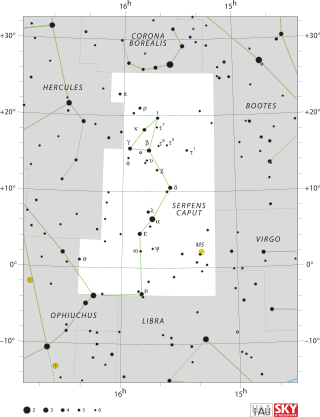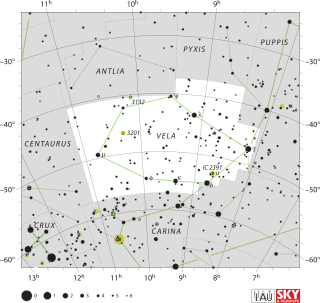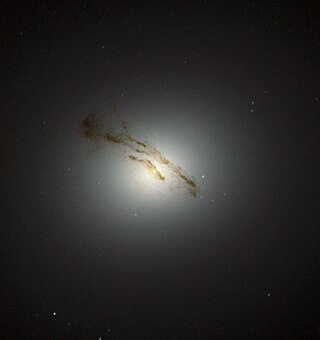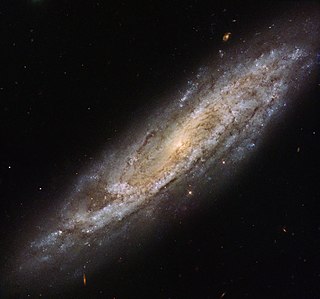Related Research Articles

Antlia is a constellation in the Southern Celestial Hemisphere. Its name means "pump" in Latin and Greek; it represents an air pump. Originally Antlia Pneumatica, the constellation was established by Nicolas-Louis de Lacaille in the 18th century. Its non-specific (single-word) name, already in limited use, was preferred by John Herschel then welcomed by the astronomic community which officially accepted this. North of stars forming some of the sails of the ship Argo Navis, Antlia is completely visible from latitudes south of 49 degrees north.

Microscopium is a minor constellation in the southern celestial hemisphere, one of twelve created in the 18th century by French astronomer Nicolas-Louis de Lacaille and one of several depicting scientific instruments. The name is a Latinised form of the Greek word for microscope. Its stars are faint and hardly visible from most of the non-tropical Northern Hemisphere.

Piscis Austrinus is a constellation in the southern celestial hemisphere. The name is Latin for "the southern fish", in contrast with the larger constellation Pisces, which represents a pair of fish. Before the 20th century, it was also known as Piscis Notius. Piscis Austrinus was one of the 48 constellations listed by the 2nd-century astronomer Ptolemy, and it remains one of the 88 modern constellations. The stars of the modern constellation Grus once formed the "tail" of Piscis Austrinus. In 1597, Petrus Plancius carved out a separate constellation and named it after the crane.

Serpens is a constellation in the northern celestial hemisphere. One of the 48 constellations listed by the 2nd-century astronomer Ptolemy, it remains one of the 88 modern constellations designated by the International Astronomical Union. It is unique among the modern constellations in being split into two non-contiguous parts, Serpens Caput to the west and Serpens Cauda to the east. Between these two halves lies the constellation of Ophiuchus, the "Serpent-Bearer". In figurative representations, the body of the serpent is represented as passing behind Ophiuchus between Mu Serpentis in Serpens Caput and Nu Serpentis in Serpens Cauda.

Telescopium is a minor constellation in the southern celestial hemisphere, one of twelve named in the 18th century by French astronomer Nicolas-Louis de Lacaille and one of several depicting scientific instruments. Its name is a Latinized form of the Greek word for telescope. Telescopium was later much reduced in size by Francis Baily and Benjamin Gould.

Vela is a constellation in the southern sky, which contains the Vela Supercluster. Its name is Latin for the sails of a ship, and it was originally part of a larger constellation, the ship Argo Navis, which was later divided into three parts, the others being Carina and Puppis. With an apparent magnitude of 1.8, its brightest star is the hot blue multiple star Gamma Velorum, one component of which is the closest and brightest Wolf-Rayet star in the sky. Delta and Kappa Velorum, together with Epsilon and Iota Carinae, form the asterism known as the False Cross. 1.95-magnitude Delta is actually a triple or quintuple star system.

Coma Berenices is an ancient asterism in the northern sky, which has been defined as one of the 88 modern constellations. It is in the direction of the fourth galactic quadrant, between Leo and Boötes, and it is visible in both hemispheres. Its name means "Berenice's Hair" in Latin and refers to Queen Berenice II of Egypt, who sacrificed her long hair as a votive offering. It was introduced to Western astronomy during the third century BC by Conon of Samos and was further corroborated as a constellation by Gerardus Mercator and Tycho Brahe. It is the only modern constellation named for a historic person.

Lynx is a constellation named after the animal, usually observed in the Northern Celestial Hemisphere. The constellation was introduced in the late 17th century by Johannes Hevelius. It is a faint constellation, with its brightest stars forming a zigzag line. The orange giant Alpha Lyncis is the brightest star in the constellation, and the semiregular variable star Y Lyncis is a target for amateur astronomers. Six star systems have been found to contain planets. Those of 6 Lyncis and HD 75898 were discovered by the Doppler method; those of XO-2, XO-4, XO-5 and WASP-13 were observed as they passed in front of the host star.

Cassiopeia is a constellation and asterism in the northern sky named after the vain queen Cassiopeia, mother of Andromeda, in Greek mythology, who boasted about her unrivaled beauty. Cassiopeia was one of the 48 constellations listed by the 2nd-century Greek astronomer Ptolemy, and it remains one of the 88 modern constellations today. It is easily recognizable due to its distinctive 'W' shape, formed by five bright stars.

Perseus is a constellation in the northern sky, named after the Greek mythological hero Perseus. It is one of the 48 ancient constellations listed by the 2nd-century astronomer Ptolemy, and among the 88 modern constellations defined by the International Astronomical Union (IAU). It is located near several other constellations named after ancient Greek legends surrounding Perseus, including Andromeda to the west and Cassiopeia to the north. Perseus is also bordered by Aries and Taurus to the south, Auriga to the east, Camelopardalis to the north, and Triangulum to the west. Some star atlases during the early 19th century also depicted Perseus holding the disembodied head of Medusa, whose asterism was named together as Perseus et Caput Medusae; however, this never came into popular usage.

Circinus is a small, faint constellation in the southern sky, first defined in 1756 by the French astronomer Nicolas-Louis de Lacaille. Its name is Latin for compass, referring to the drafting tool used for drawing circles. Its brightest star is Alpha Circini, with an apparent magnitude of 3.19. Slightly variable, it is the brightest rapidly oscillating Ap star in the night sky. AX Circini is a Cepheid variable visible with the unaided eye, and BX Circini is a faint star thought to have been formed from the merger of two white dwarfs. Two sun-like stars have planetary systems: HD 134060 has two small planets, and HD 129445 has a Jupiter-like planet. Supernova SN 185 appeared in Circinus in 185 AD and was recorded by Chinese observers. Two novae have been observed more recently, in the 20th century.

Reticulum is a small, faint constellation in the southern sky. Its name is Latin for a small net, or reticle—a net of crosshairs at the focus of a telescope eyepiece that is used to measure star positions. The constellation is best viewed between October and December, and save for one main star visible in ideal conditions, cannot be seen from north of the 30th parallel north.

Leo Minor is a small and faint constellation in the northern celestial hemisphere. Its name is Latin for "the smaller lion", in contrast to Leo, the larger lion. It lies between the larger and more recognizable Ursa Major to the north and Leo to the south. Leo Minor was not regarded as a separate constellation by classical astronomers; it was designated by Johannes Hevelius in 1687.

Corvus is a small constellation in the Southern Celestial Hemisphere. Its name means "crow" in Latin. One of the 48 constellations listed by the 2nd-century astronomer Ptolemy, it depicts a raven, a bird associated with stories about the god Apollo, perched on the back of Hydra the water snake. The four brightest stars, Gamma, Delta, Epsilon, and Beta Corvi, form a distinctive quadrilateral or cross-shape in the night sky.

Messier 84 or M84, also known as NGC 4374, is a giant elliptical or lenticular galaxy in the constellation Virgo. Charles Messier discovered the object in 1781 in a systematic search for "nebulous objects" in the night sky. It is the 84th object in the Messier Catalogue and in the heavily populated core of the Virgo Cluster of galaxies, part of the local supercluster.
Gliese 65, also known as Luyten 726-8, is a binary star system that is one of Earth's nearest neighbors, at about 8.7 light years from Earth in the constellation Cetus. The two component stars are both flare stars with the variable star designations BL Ceti and UV Ceti.

Luminous blue variables (LBVs) are massive evolved stars that show unpredictable and sometimes dramatic variations in their spectra and brightness. They are also known as S Doradus variables after S Doradus, one of the brightest stars of the Large Magellanic Cloud. They are considered to be rare.

The Katzman Automatic Imaging Telescope (KAIT) is an automated telescope used in the search for supernovae.

NGC 2770 is a spiral galaxy in the northern constellation of Lynx, near the northern constellation border with Cancer. It was discovered by German-born astronomer William Herschel on December 7, 1785. J. L. E. Dreyer described it as, "faint, large, much extended 150°, mottled but not resolved, 2 stars to north". NGC 2770 was the target for the first binocular image produced by the Large Binocular Telescope.

NGC 3294 is a spiral galaxy in the constellation Leo Minor. It was discovered by William Herschel on Mar 17, 1787. It is a member of the Leo II Groups, a series of galaxies and galaxy clusters strung out from the right edge of the Virgo Supercluster. The galaxy is located at a distance of 98 million light years and is receding with a heliocentric radial velocity of 1,586 km/s. The morphological class of NGC 3294 is SA(rs)bc, which means this is a spiral galaxy with no central bar (SA), an incomplete inner ring structure (rs), and moderately wound spiral arms (bc).
References
- ↑ "NameExoWorlds: An IAU Worldwide Contest to Name Exoplanets and their Host Stars" (Press release). IAU.org. 9 July 2014.
- ↑ "Final Results of NameExoWorlds Public Vote Released" (Press release). IAU.org. 15 December 2015.
- ↑ "NameExoWorlds". nameexoworlds.iau.org.
- ↑ "IAU Working Group on Star Names (WGSN)" . Retrieved 22 May 2016.
- ↑ "Bulletin of the IAU Working Group on Star Names, No. 1" (PDF). Retrieved 28 July 2016.
- ↑ "Naming Stars". IAU.org. Retrieved 17 June 2018.
- ↑ R.H. Allen, Star Names: Their Lore and Meaning.
- ↑ Robert Burnham, Jr. Burnham's Celestial Handbook, Volume 1, p. 359.
- ↑ Ian Ridpath: "Star Tales", Canes Venatici. See also Deborah J. Warner, The Sky Explored: Celestial Cartography 1500–1800.
- ↑ "Approved names". NameExoworlds. Retrieved 2 January 2020.
- 1 2 3 4 5 Fernandez, M.; Lortet, M-C.; Spite, F. (June 1983). "The First Dictionary of the Nomenclature of Celestial Objects (solar system excluded)". Astronomy and Astrophysics . 52 (4): 1.1–7.14. Bibcode:1983A&AS...52....1F.
- ↑ "Our Astronomical Column". Nature . 26 (654): 42. 11 May 1882. Bibcode:1882Natur..26Q..42.. doi: 10.1038/026042a0 . ISSN 0028-0836. S2CID 4081301.
- ↑ "A Pulsar Discovery – Moments of Discovery". American Institute of Physics . Retrieved 9 December 2021.
- ↑ Cameron, Robert C.; Perry, Charles (1 March 1961). "Narrow-Band Photometry of Babcock's Magnetic Star HD 215441". The Astronomical Journal . 70: 40. Bibcode:1961AJ.....66R..40C. doi: 10.1086/108524 . ISSN 0004-6256.
- ↑ Burnham's Celestial Handbook, an observer's guide to the universe beyond the solar system (Robert Burnham, Jr.), page 311.
- ↑ Penston, M. V.; Allen, D. A.; Hyland, A. R. (November 1971). "The Nature of Becklin's Star". The Astrophysical Journal . 170: L33. Bibcode:1971ApJ...170L..33P. doi: 10.1086/180835 . ISSN 0004-637X.
- ↑ Jaschek, C.; Jaschek, M.; Morgan, W. W.; Slettebak, Arne (1 August 1968). "On the Spectrum of Bidelman's Helium Variable Star HD 125823". The Astrophysical Journal. 153: L87. Bibcode:1968ApJ...153L..87J. doi: 10.1086/180227 . ISSN 0004-637X.
- ↑ Heard, John Frederick (31 May 1962). "The spectroscopic orbit of Bidelman's peculiar star H.D. 30353". Publications of the David Dunlap Observatory . 2 (9): 269–277. Bibcode:1962PDDO....2..269H.
- ↑ Turner, D. G.; Lyons, R. W. (1 February 1980). "Recent observations of HD 127617 – Bidelman's high-latitude Be star". Journal of the Royal Astronomical Society of Canada . 74: 12–16. Bibcode:1980JRASC..74...12T. ISSN 0035-872X.
- ↑ Sky Catalogue 2000.0, Volume II: Double Stars, Variable Stars and Nonstellar Objects. Page xlv, Glossary of Selected Astronomical Names, Bond's Flare Star
- ↑ Deep-Sky Name Index 2000.0, Hugh C. Maddocks (Foxon-Maddocks Associates).
- ↑ "British Astronomical Association Circular No. 615" (PDF). British Astronomical Association. 4 March 1981. Retrieved 9 December 2021.
- ↑ Mathys, G.; Lanz, T. (March 1992). "Ap stars with resolved magnetically split lines". Astronomy and Astrophysics. 256: 169–184. Bibcode:1992A&A...256..169M.
- ↑ Andrews, A. D.; Butler, C. J.; Eksteen, J. P. (26 September 1966). "Further Flare Activity in Butler's Star in the SMC". Information Bulletin on Variable Stars . Konkoly Observatory . Retrieved 9 December 2021.
- ↑ "A smouldering star". ESA Hubble. 16 September 2013. Retrieved 9 December 2021.
- 1 2 Dibai, É. A.; Esipov, V. F.; Pronik, V. I. (1 April 1967). "Spectra of the Chavira and Rosino Supernovae". Soviet Astronomy. 10: 728. Bibcode:1967SvA....10..728D. ISSN 0038-5301.
- 1 2 Borzov, G. G.; Dibai, É. A.; Esipov, V. F.; Pronik, V. I. (1 December 1969). "Observations of Chuadze's and Wild's Supernovae". Soviet Astronomy . 13: 423. Bibcode:1969SvA....13..423B. ISSN 0038-5301.
- ↑ Sky Catalogue 2000.0, Volume 2, page xlvi, Glossary of Selected Astronomical Names
- ↑ Kodaira, K.; Lye, M.; Watanabe, M.; Hamabe, M.; Okamura, S. (1979). "Note: Chu's Object in Perseus". Publications of the Astronomical Society of Japan . 31: 417–422. Bibcode:1979PASJ...31..417K. ISSN 0004-6264.
- ↑ Bohm, K. H.; Bohm-Vitense, E. (December 1982). "Ultraviolet radiation from the environment of the Cohen-Schwartz star". The Astrophysical Journal. 263: L35–L38. Bibcode:1982ApJ...263L..35B. doi: 10.1086/183918 . ISSN 0004-637X.
- ↑ Sky and Telescope, 53, February 1977, page 107
- ↑ Jones, D. (2002). Is Fehrenbach's Star Unique?. Omega Centauri, A Unique Window into Astrophysics. Omega Centauri. Vol. 265. p. 227. Bibcode:2002ASPC..265..227J.
- ↑ Sky and Telescope 1/2005, page 101
- ↑ Barnard, E. E. (1921). "Hind's New Star of 1848 (Nova Ophiuchi No. 2)". Monthly Notices of the Royal Astronomical Society . 81: 167. Bibcode:1921MNRAS..81..167B. doi: 10.1093/mnras/81.3.167 . ISSN 0035-8711.
- ↑ Sky Catalogue 2000.0, page xlvii; Glossary of Selected Astronomical Names
- ↑ Berthold, Thomas (March 1981). "Remarks on 6 Variable Stars". Information Bulletin on Variable Stars . 1942: 1. Bibcode:1981IBVS.1942....1B. ISSN 0374-0676.
- ↑ Matsumoto, Katsura; Nogami, Daisaku; Kato, Taichi; Baba, Hajime (August 1998). ""Huruhata's Variable" Revealed: The WZ Sge-Type Dwarf Nova EG CANCRI". Publications of the Astronomical Society of Japan. 50 (4): 405–409. Bibcode:1998PASJ...50..405M. doi: 10.1093/pasj/50.4.405 . ISSN 0004-6264.
- ↑ William R. Corliss: Mysterious Universe, a handbook of astronomical anomalies (The Sourcebook Project, 1979), page 500
- ↑ Nature, 14:291-292, 1876
- ↑ "Innes\' star". simbad.u-strasbg.fr.
- ↑ "Kapteyn b and c: Two Exoplanets Found Orbiting Kapteyn's Star". Sci-News. Archived from the original on 3 August 2014. Retrieved 1 October 2022.
- ↑ Briscoe, Luke (3 June 2015). "A star is named: Eddie Mabo honoured in star dedication". NITV . Retrieved 11 December 2021.
- ↑ Briscoe, Luke (3 June 2015). "Eddie Mabo: It was written in the stars". NITV . Retrieved 11 December 2021.
- ↑ "Library Guides: Eddie Koiki Mabo Timeline: 2015". Library Guides at James Cook University. 19 February 2020. Retrieved 11 December 2021.
- 1 2 "Publications of the Variable Star Section No. 20" (PDF). Variable Stars South. Royal Astronomical Society of New Zealand. 20 November 1995.
- ↑ Sky & Telescope, February 1968, page 97
- ↑ Johnson, John (2016). How do you find an Exoplanet?. New Jersey: Princeton University Press. p. 137. ISBN 978-0-691-15681-1.
- ↑ van Genderen, A. M. (December 1975). "Photometry of the Be star Wray 795 and some other stars in the Cen X-3 area". Astronomy and Astrophysics. 45: 425–427. Bibcode:1975A&A....45..425V.
- ↑ Burnham's Celestial Handbook, page 641
- ↑ Johnson, M. (June 1953). "Luyten's flare star and its limited affinities with solar, T Tauri and SS Cygni eruptions". The Observatory . 73: 109–112. Bibcode:1953Obs....73..109J. ISSN 0029-7704.
- ↑ Duerbeck, H. W.; Reipurth, B. (May 1990). "We 21 : A WN 8 star in a planetary nebula". Astronomy and Astrophysics. 231: L11–L14. Bibcode:1990A&A...231L..11D. ISSN 0004-6361.
- ↑ Sky Catalogue 2000.0 (page xlviii, Glossary of Selected Astronomical Names)
- ↑ Schoeneich, W.; Zelwanowa, E. I. (1985). "Der Lichtwechsel des Ap-Sterns HD 221568 (Osawas Stern) in zehn Spektralbereichen". Astronomische Nachrichten. 306 (4): 189–192. Bibcode:1985AN....306..189S. doi:10.1002/asna.2113060404. ISSN 0004-6337.
- ↑ Burnham's Celestial Handbook, page 503
- ↑ Reipurth, Bo; Aspin, Colin; Beck, Tracy; Brogan, Crystal; Connelley, Michael S.; Herbig, G. H. (March 2007). "V733 Cep (Persson's Star): A New FU Orionis Object in Cepheus". The Astronomical Journal. 133 (3): 1000–1011. Bibcode:2007AJ....133.1000R. doi: 10.1086/510617 . ISSN 0004-6256. S2CID 119546712.
- ↑ Schoenberner, D.; Wolf, R. E. A. (December 1974). "Fine analysis of Popper's star HD 124448". Astronomy and Astrophysics. 37: 87–96. Bibcode:1974A&A....37...87S.
- ↑ Goranskij, V. P. (1972). "Observations of the supernova SVS 1854 and Roberts-Altizer's variable in the vicinity of NGC 3147". Astronomicheskij Tsirkulyar. 723: 6–8. Bibcode:1972ATsir.723....6G.
- ↑ Wenzel, W. (June 1965). "Object Rosino-Zwicky Near M88". Information Bulletin on Variable Stars. 99: 1. Bibcode:1965IBVS...99....1W. ISSN 0374-0676.
- ↑ Heo, Jeong-Eun; Angeloni, Rodolfo; Mille, Francesco Di; Palma, Tali; Lee, Hee-Won (21 December 2016). "A PROFILE ANALYSIS OF RAMAN-SCATTERED O VI BANDS AT 6825 Å AND 7082 Å IN SANDULEAK'S STAR". The Astrophysical Journal. 833 (2): 286. arXiv: 1610.07157 . Bibcode:2016ApJ...833..286H. doi: 10.3847/1538-4357/833/2/286 . ISSN 1538-4357. S2CID 55486008.
- ↑ Greenstein, J. L.; Dolez, N.; Vauclair, G. (November 1983). "Physical properties and evolution of the two white dwarfs in the Sanduleak-Pesch binary". Astronomy and Astrophysics. 127: 25–28. Bibcode:1983A&A...127...25G.
- ↑ Sky Catalogue 2000.0, page xlix, Glossary of Selected Astronomical Names
- ↑ Hager, J. G. (1903). "Discussion of a Questionable Type of Temporary Stars". The Astrophysical Journal. 17: 281–285. Bibcode:1903ApJ....17..281H. doi:10.1086/141026.
- ↑ Burleigh, M. R.; Heber, U.; O'Donoghue, D.; Barstow, M. A. (10 February 2000). "The Schweizer-Middleditch star revisited". Astronomy and Astrophysics. 356: 585. arXiv: astro-ph/0002236 . Bibcode:2000A&A...356..585B.
- ↑ Vescovi, D.; Busso, M.; Palmerini, S.; Trippella, O.; Cristallo, S.; Piersanti, L.; Chieffi, A.; Limongi, M.; Hoppe, P.; Kratz, K-L. (16 August 2018). "On the Origin of Early Solar System Radioactivities: Problems with the Asymptotic Giant Branch and Massive Star Scenarios". The Astrophysical Journal. 863 (2): 115. arXiv: 1807.01058 . Bibcode:2018ApJ...863..115V. doi: 10.3847/1538-4357/aad191 . ISSN 1538-4357. S2CID 119220294.
- ↑ Horne, Keith (December 1980). "Stepanyan's star - A new eclipsing cataclysmic variable". The Astrophysical Journal. 242: L167. Bibcode:1980ApJ...242L.167H. doi:10.1086/183425. ISSN 0004-637X.
- ↑ Sky and Telescope 6-2005, page 108
- ↑ Hoffleit, Dorrit (September 1952). "Wachmanns Forgotten Flare Star". Harvard College Observatory Bulletin . 921: 5–6. Bibcode:1952BHarO.921....5H. ISSN 0891-3943.
- ↑ Shenar, T.; Sablowski, D. P.; Hainich, R.; Todt, H.; Moffat, A. F. J.; Oskinova, L. M.; Ramachandran, V.; Sana, H.; Sander, A. A. C.; Schnurr, O.; St-Louis, N. (2020). "The Wolf-Rayet binaries of the nitrogen sequence in the Large Magellanic Cloud. Spectroscopy, orbital analysis, formation, and evolution". Astronomy and Astrophysics. 627: A151. arXiv: 1905.09296 . Bibcode:2019A&A...627A.151S. doi:10.1051/0004-6361/201935684. ISSN 0004-6361. S2CID 162183986.
- ↑ Cowley, A. P.; Crampton, D.; Hutchings, J. B.; Remillard, R.; Penfold, J. E. (September 1983). "Discovery of a massive unseen star in LMC X-3". The Astrophysical Journal. 272: 118–122. Bibcode:1983ApJ...272..118C. doi:10.1086/161267. ISSN 0004-637X.
- ↑ Menzies, J. W.; Tanzi, E. G.; Tarenghi, M. (March 1981). "Supernova (Evans) in NGC 1316". International Astronomical Union Circular (3589): 1. Bibcode:1981IAUC.3589....1M. ISSN 0081-0304.
- ↑ Wierzbik, Chris (28 February 1993). "Reaching for the Stars". Chicago Tribune. p. 1. Archived from the original on 25 October 2015.
- ↑ "Buying Stars and Star Names". IAU. Retrieved 10 September 2015.